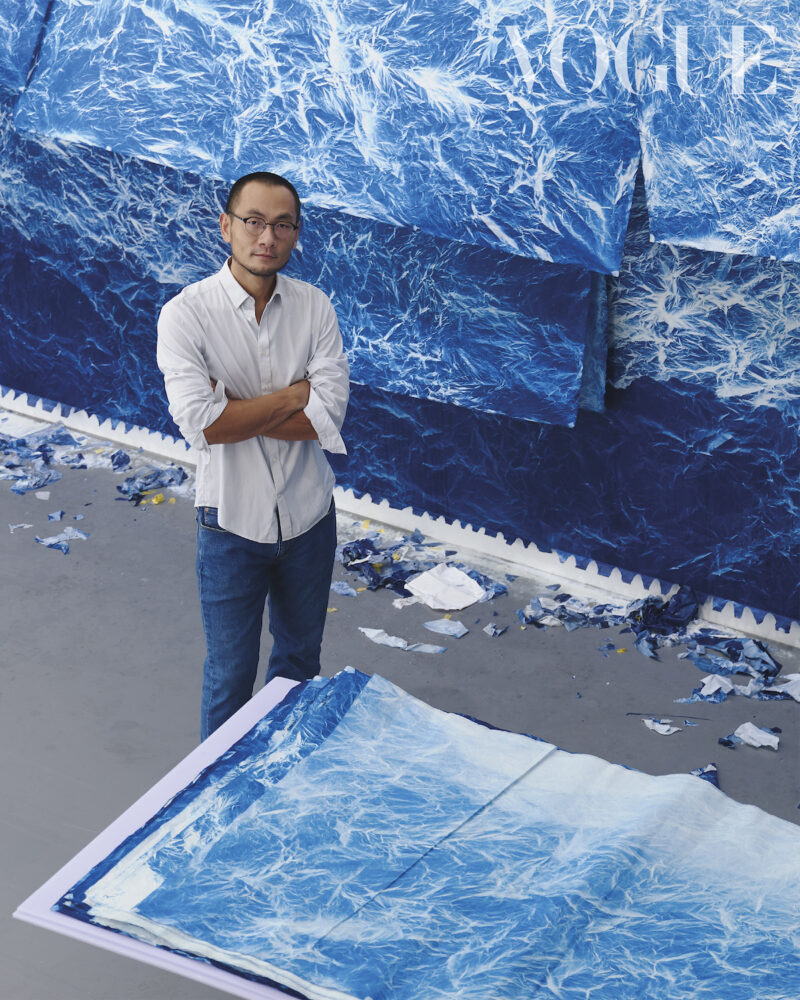
Bustling back and forth over cities across the world, Wu Chi-Tsung dexterously shuttled through the art world, as if it was a natural practice. This day we came to Wu Chi-Tsung’s new studio in Tamsui, Taipei. Apart from here, he also has studios in Yuanshan in Taipei, Berlin, and Ho Chi Minh City. These studios scattered around the world are not only for practical needs but also for Wu Chi-Tsung’s strategy of observing the world.
A studio space that can accommodate museum level presentation
“This is the most well-equipped space I have ever had. It’s like working in an art museum.” Wu Chi-Tsung sat in a corner of his new studio, and the sunlight fell through the large glass windows and landed on his shoulders.
This new studio is located in the residential area of Danhai New Town. Facing a wide, neat street, it locates on the first floor with high ceilings. Here, Wu Chi-Tsung drives a scissor lift, ascending and descending in the spacious space, busy making two huge “Cyano-Collage Series” to be exhibited at Sean Kelly Gallery in New York. This will be his first solo exhibition in New York– his new studio coming out of a need for this work.
The main exhibition hall of Sean Kelly Gallery in New York is the size of a basketball court. Two large works are required, which are difficult to be accommodated in his old Yuanshan studio. “In Yuanshan, when you want to see the complete composition of the work, you have to open the iron rolling door on the first floor and retreat across the road.” One of the new “Cyano-Collage Series” scales three meters by nine meters in size. “It is unlikely that I would create works larger than this anymore. We have already challenged the limits of the new space by creating it” While standing in front of the large “Cyano-Collage Series” work, people would feel as if they are in a real mountain, and would almost lose control to dive in.
A studio is different from an art gallery. It is a place where the artist lowers his head and sweats to work. However, Wu Chi-Tsung planned his new studio according to the specifications of an exhibition hall, aligning the working environment with the exhibition conditions. Therefore, “Before I arrive in New York, I can already accurately foresee what the work looks like on-site.” He said that the most difficult aspect of space planning is to master good scale and proportions. For example, some exhibition spaces have very high ceilings, but the proportion between the work and the space as well as between viewers and the space may be weird. Having spacious space and high ceilings do not necessarily bring enjoyable visiting experiences.
During his creating process, Wu Chi-Tsung skillfully uses scaffolding and scissor lifts to move across the work, like playing with a toy. “Compared to see the completed work at the exhibition site, where everything is neatly presented, sometimes the creative process is more interesting.” Wu says, looking up at the “Cyano-Collage Series”, the upper part of which has not yet been completed. Xuan papers are selected to be mounted on the aluminum plate, blowing under the fanlike ocean waves. ” Normally audiences won’t have the chance to see this kind of scene of the Cyano-Collage Series. The nature of this work is actually a collage of randomnesses formed by wrinkled pieces of Xuan paper.”
Wu Chi-Tsung said that interacting with materials and technology is what he finds the most interesting. With a large high-ceilinged studio and the help of scaffolding and scissor lifts, he is able to change the way of interacting with his works. “When people see what is behind-the-scene, they can understand how the work is created step by step and will have a completely different understanding to the work.” Chi-Tsung and his team have moved to the new studio for less than a month, and there is already a thin layer of paper scraps and glue on the ground underneath the work. “This is a habit of mine in the studio. Basically, everyone is not allowed to clean up the ground.”
Everything that happened in the studio left traces. When the artist picks his brush, the glue drips along the way and leaves marks. When piles of Xuan paper soaked in photosensitive solution generally turn into different shades of blue, they would dye the floor on the ground.” In contrast, I will feel a lot of pressure if the space is too neat and tidy, so I will have to be constantly aware of not to mess the space up, and my attention will be distracted.” In the artist’s studio, randomness can also be a precious inspiration. ‘
Physical and spiritual polished by trainings of rock-climbing
“I also plan to install a climbing wall here.” Until now, Wu Chi-Tsung still always recalls the training time when he was in the rock climbing team back in high school. He shared with us the three-day round of intensive training routine at that time. Back then, he only wanted to be stronger and freer. Rock climbing is all about the present. Wu Chi-Tsung said “Sometimes you will find yourself in a tricky stage seven or eight stories above the ground. You may fall at any time. And this is time you have to think about nothing but to concentrate on every action at the moment.” Rock climbing and art creation are similar things, both require your spirituality and physicality to be present. When you challenge the limitations of your body, you may find the essence of your existence. “It’s a kind of freedom.”
“Freedom” has always been a keyword to Wu Chi-Tsung: the freedom to exceed the limits of the body when exercising, the freedom to imagine when creating. “However, freedom does not mean to do anything without rules, but something that I, the materials and tools in my hand conform to each other and develop together in the most natural and comfortable state of each other.”
Looking at the half-completed “Cyano-Collage Series” on one side of the studio and the wall with only aluminum panels on the other side, Wu introduces, “These two huge works are like marathons. They are very tiring and require strong organizational skills and concentration, but I enjoy this unprecedented challenge a lot.” After this, he jumped on the scissor lift again, taking the time to finish the ‘clouds’ on the aluminum plate.
Awakening the Study on Materials of Traditional Media
Wu Chi-Tsung has received art training from both Eastern and Western sources, which is a common upbringing in Taiwan. “We actually grew up bilingual, and it is unlikely that a Western artist would have practiced calligraphy and ink painting since childhood, but Asian artists are generally trained in Western art, and this is obviously our best characteristic and competitive advantage.” This has prompted him to reexamine the classic as well as learn from the West, to explore personal, regional, and contemporary particularities, and to try to mend the gap between East and West, tradition and modernity.
Wu Chi-Tsung believes that it will be a hard act to follow what has been achieved by the ancient people, so he has taken a different path by replacing ink and brush with other media and using experimental photography to continue the landscape tradition. He said, “After all, the ancients could not be possible to climb onto the rock wall and observe them as I do. “
For the “Cyano-Collage” series, Wu Chi-Tsung conducted research on Xuan paper, learning about the material.
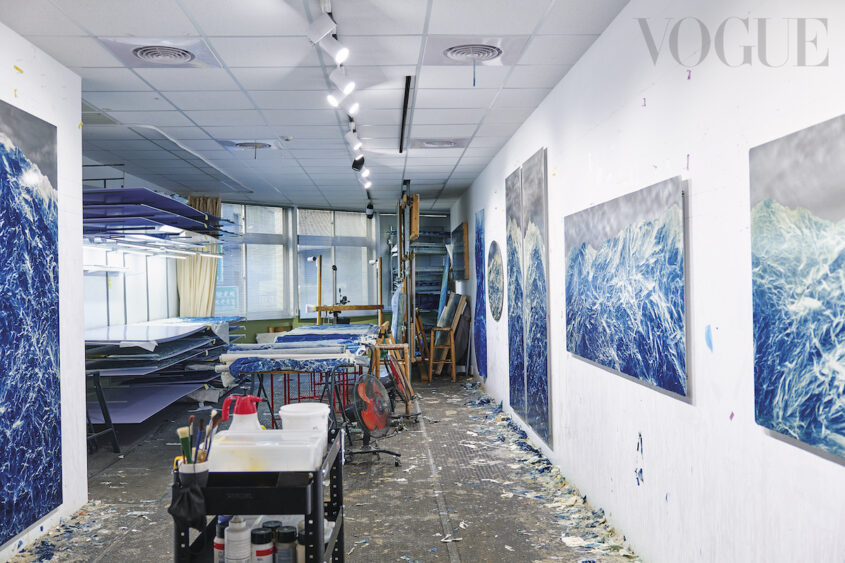
In 2018, he established a studio in a residential building with a rooftop in Yuanshan. The daily routine of this studio was almost revolving around “paper” and the four floors of the building each has their own function:the rooftop for exposing cyanotype-treated xuan paper, the fourth floor for “washing” the paper and other machinery works, the third floor for the creation and presentation of the works, and the paper scraps and traces of glue on the floor of the second floor have reached the thickness of snow…“In order to find the most suitable type of xuan paper for the cyanotype process, we have experimented on dozens of types of them. By countless research and experiments, we get to understand the material better”. This is also what he differs from painters and calligraphers from the past. To Wu, xuan paper is the paper with the most complicated and sensitive quality among all. With different manufacturing methods, they are capable to carry out broad color variations of ink that are extremely delicate.
The cultivation of the two cultures of the East and the West gave Wu Chi-Tsung a broader mind and vision, and his works that combined Western contemporary media and the spirit of Eastern aesthetics translated the world they were not familiar with to Western audiences. “Through my work, xuan paper is able to be noticed by more people. For example, when I was exhibiting in Europe when the audience learned about the production process of the “Cyano-Collage Series”, they were all amazed by the outstanding resilience of the xuan paper after being crumpled, flattened, soaked, and dried. If in this way, more artists from other countries will also start to become interested in this material and begin to use it in their creations, can this traditional eastern media breathe a new life in the contemporary art world? “If 20% of the artists working with paper in Europe adapt xuan paper, the whole industry will be resurrected.”
Wu Chi-Tsung believes that the overall consideration and management of art from the stage of the production of materials is a practical matter. “I spend so much time researching materials, of course, I hope that it will continue to be produced. People tend to think that art is something remote and abstract. In fact, it IS such a practical thing. Interacting with materials and technology is part of the creation.”
Be natural, be harmonic
Behind the huge Cyano-Collage landscape, the research and application of materials also embody Eastern philosophies and fundamentally establish the aesthetic tone and value orientation of the works. “Western paper was developed for a high degree of control, while Eastern paper has a high degree of variability in aesthetic values.” This is the so-called “naturally.” When creating, Wu Chi-Tsung thought about how to make the material develop. For example, rice paper is thin and tough. When crumpled, its characteristics can be expressed naturally. But if you make origami, expect it to have a specific shape, “I will do it very painfully, and the paper will probably be very uncomfortable.” The idea of control arises, and the characteristics of paper cannot be unfolded, so the more you create, the more limited it becomes.
It is necessary to minimize control and allow the integration of materials and technologies to occur naturally. Only then can the underlying “own being” unfold. He showed us the pottery he made in his spare time during the Covid-19 pandemic. He said that while making pottery, you also need to learn to interact with the clay, not attempting to control them. “Every material has its own character, just like people, we can only follow it to dig out its unique texture, or the unique chemical reaction between me and the material.”
International studio across Europe and Asia
Speaking of his life as an international artist, Wu Chi-Tsung introduces, “If it weren’t for the Covid-19, I would be spending maybe only one-third of the year in Taiwan, and other times I would be living, creating, finding inspiration, or conducting research on materials and technology in my studios around the world.”
The two huge “Cyano-Collage Series” on the wall of the Tamsui studio will be sent to the United States immediately after completion. While being asked why not consider establishing a studio in New York? Wu Chi-Tsung replied, “New York is too charming for anyone to dislike. But it may not be suitable as a base for artists to create.” In 2013, Wu Chi-Tsung was granted by the Asian Cultural Council (ACC) for a half-year residency program. It is when he realized that the high cost of goods and intense competition made it a difficult place to live and work in as a young artist. “It’s not a place where people can calm down and be focused.”
“I like Vietnam very much. Compared with New York, it is a jungle where everything is in a very initial and chaotic state.” It is an art world that is growing and forming its shape, and the experience here is unprecedented. “For example”, Wu Chi-Tsung said, “if you hold an open studio in Saigon, half of the Saigon art circle will show up, and the art ecology here is a close community. ” Berlin is an intermediate value for Wu Chi-Tsung. The historical background and economic structure of the city have brought artists from all over the world into the city, forming another spectacle full of life. “Berlin has changed a lot. My studio is the place where the secret police gathered in the old East Germany.” The history of political prisoners and the political atmosphere of the East German era are still there, but at the same time, it is an inclusive city “Why there can there be so many interesting things happening in Berlin? The relatively low price is absolutely the key.” Because the space cost is low, you can try as much as you want without the pressure to succeed.
Free artistic spirit
He added that as an artist, he is very lucky. He travels around the world and communicates with different people. Through traveling and working in various cities, he accumulates the experience of interacting with different people. He sees that people have very different imaginations towards what it means to work with art.
“Most people consider that artists are people who make works, which is incorrect. The creation of works is only part of the work. What we do is ‘the whole thing about art’.” Wu Chi-Tsung said. “Including academic research, art market operation, international relations, and even thinking about the production of materials. The international studio layout allows him to integrate information and resources most efficiently, and to re-recognize himself from the perspective of others so that he can really know himself and understand his uniqueness compared to others. “When I was in Taiwan, I didn’t think there were any problems; after I left Taiwan, I could see its characteristics and limitations.”
He chose to transcend limitations. He is exploring to make use of his studios in Berlin, Ho Chi Minh City, Yuanshan, and Tamsui. In each of them, an aspect of Wu Chi-Tsung’s personality dwells. Shuttling between the past and now, east and west, his personality and creativity never stop growing.
The settings of these studios seem to be rational and full of logic, but they actually more of a natural result of Chi-Tsung’s career development to fit his need than a deliberate arrangement. . And the fundamental reason that drives him to bravely cross the border may be just the kind of spirit he has experienced in many years of rock climbing training, that is, beyond the limits, the spirit of freedom.
Editor Nicole Lee
Text by Jing
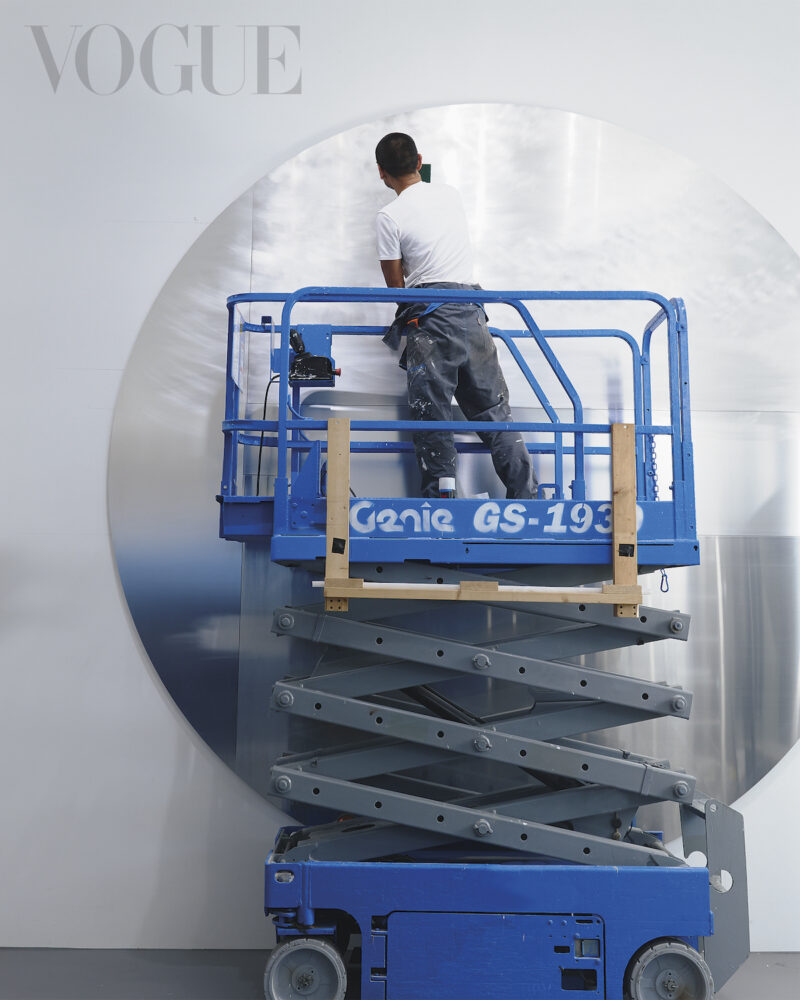
在隔著海陸的城市間忙碌來回,吳季璁靈巧地穿梭藝術世界,仿若修行般的自然而然。這天我們來到吳季璁位於淡水的新工作室,除了此處,他在台北圓山、德國柏林和越南胡志明市,都還有工作空間,這些散落世界各處的工作室,不僅只為了創作需要,更是吳季璁觀看世界的策略。
美術館規格的創作空間
「這是我用過最高級的空間,簡直是在美術館裡面做東西一樣。」吳季璁坐在淡水新工作室的一角,陽光穿過大片玻璃,落在他肩上。
這個新的工作室座落在淡海新市鎮住宅區,街道寬闊,一樓挑高氣派。吳季璁駕駛著高空作業車,在偌大的方正空間中上升下降,忙著製作即將前往紐約 Sean Kelly Gallery展覽的巨幅《氰山集》系列新作。這將是他首次在紐約的個人展覽,而這個新工作室基本上也是為此誕生。
紐約 Sean Kelly Gallery的主展場有籃球場這麼大,需要兩件大型作品,原有的圓山工作室空間受限。「在圓山,要看作品完整構圖時,得把一樓的鐵捲門打開退到馬路對街,才能看到整體。」新工作室挑高五米七,主牆寬度十米,牆面上一幅創作中的《氰山集》,尺寸是三米乘九米。「應該很少會有比這個尺幅更大的作品了,已經用到這個空間的極限。」巨幅的《氰山集》像一座巨山真的矗立於眼前,稍一走神就想往作品裡面奔去。
工作室和美術館不同,那裡是藝術家低頭流汗工作的場所,但吳季璁以展場的規格規劃工作室,把工作環境與展覽條件拉齊。還沒到紐約,就能準確掌握作品在現場的模樣。他說空間規劃最困難的是掌握好的尺度和比例,像很多展覽空間,高度過高,反而觀看的距離感未必合適,大的確有很多好處,但不見得大就是好。
配合拍攝,吳季璁靈活地攀上鷹架,展示高空作業車上升下降,像在玩玩具。「比起展覽現場看到完成的作品,所有東西收得工工整整,有時候創作的過程反而更有趣。」抬頭看《氰山集》天際線的那一道還沒有完成,已經挑好的紙浮貼在鋁板上,冷氣吹拂它們像海浪飄動。「一般觀眾大概不太會有機會看到這樣的畫面氰山集其實是在一堆隨機偶然的皺褶碎片中,慢慢交織而成。」
吳季璁說和材料、技術互動是最有趣的,有了大工作室,高空作業車和鷹架,改變了他和作品互動的可能性。「如果大家可以看到這樣的東西,你可以理解作品是怎麼一步一步創造出來,對它的想像會完全不一樣。工作室啟用不到一個月,在作品正下方的地面已有一層薄薄的紙屑和殘膠。「我工作的空間有個習慣,地面基本上不准大家清理。」
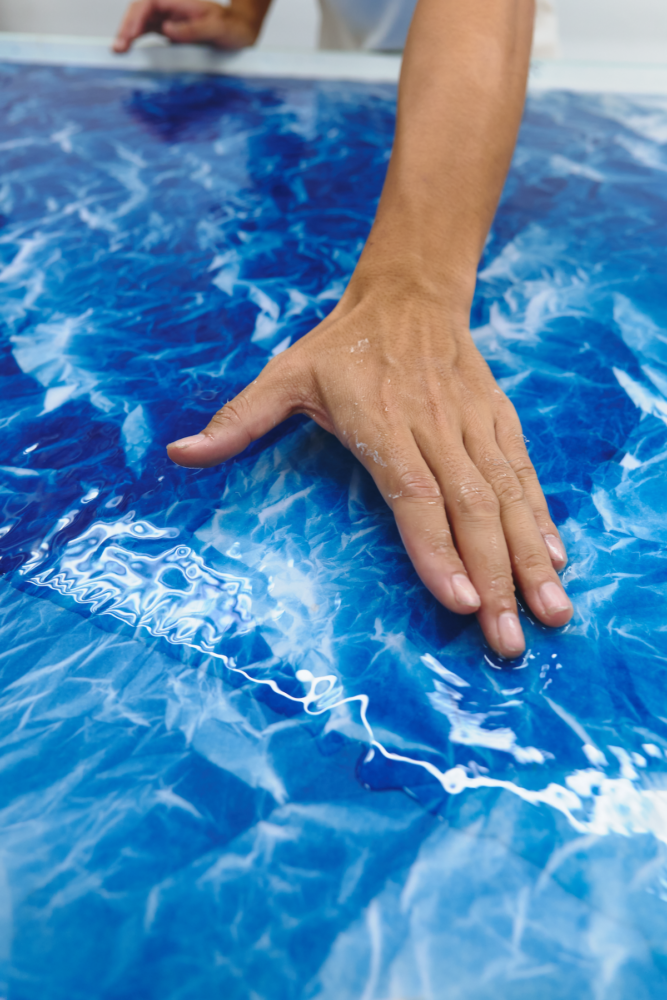
所有發生在工作室的事情都留下痕跡。刷子舉起來,膠是沿路滴,不同的氰版相紙在地上累積不同的深淺的藍色,「回頭去看這些髒亂的痕跡,都是每一段時間工作的記憶,反過來說,如果工作空間非常乾淨整潔,我會覺得壓力很大,得時時擔心弄髒環境,注意力一直被分散。」在藝術家工作室,不修邊幅的隨意也是一種記載歷史的方式。
攀岩訓練中打磨的身心狀態
「我還打算在這裡弄一塊攀岩牆。」到現在,吳季璁還很懷念高中時作為攀岩選手的訓練,他分享當時三天一輪的訓練菜單,當時一心只想讓自己變強, 心無雜塵。攀岩是一件徹底當下的事,吳季璁說:「有時在一個離地面七、八層樓高的難關,去挑戰自己能力極限的動作,隨時可能墜落,只能心無旁騖專注在當下的每個動作。「攀岩和創作都是,你的精神性和身體性是一致的。超越你身體、物質各方面的侷限,那個東西是人存在的重點,那是一種自由。」
「自由」始終是一個關鍵詞:運動時超越身體極限的自由,創作時想像馳騁的自由。「然而自由並不意味著毫無章法地任意而為,而是我與手中的材料、工具一起相互順應、彼此在最自然舒展的狀態下共同發展出來的東西。」
望向工作室一面完成過半的《氰山集》和另一面還只有鋁板的牆面,「這兩件巨幅作品是超級馬拉松,非常累,需要極強的組織能力與專注力,可是我很喜歡這個前所未有的挑戰。」說完,他又跳上牆面,抓空檔刷起鋁板上的雲朵。
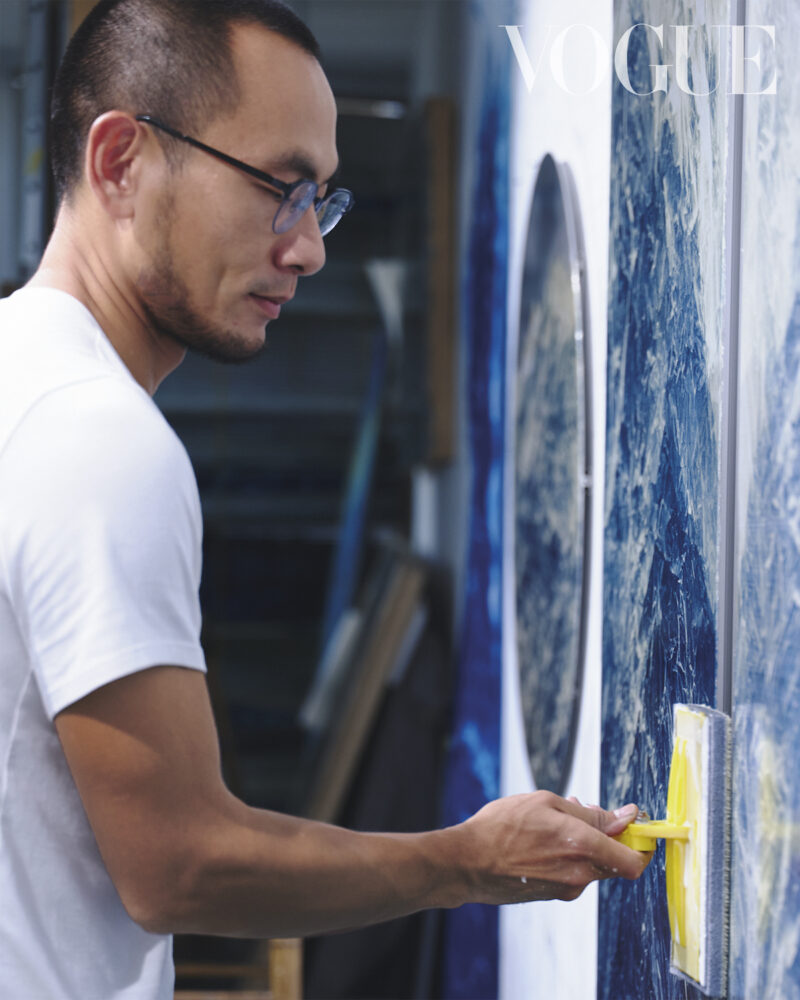
喚醒傳統媒材的材料學研究
吳季璁從小在美術班,接受著東西方兩種脈絡的藝術訓練,這樣的養成在台灣是常見的。「我們其實是學雙語長大,西方的藝術家不大可能從小練書法,畫水墨,但亞洲藝術家的養成普遍也受西方藝術的訓練,這顯然是最好的特色跟競爭優勢。」這促使他觀望古人,也與西方相比較,挖掘個人的,地域的,和當代的特殊性,試圖在東方與西方,傳統與現代之中修補斷裂。
吳季璁認為,古人在書畫技法上達成的成就他永遠無法望其項背,才另闢蹊徑,以其他的媒材取代筆墨,用實驗攝影的方式去延續山水意境。談及優勢,他則笑說「古人可沒法像我這樣貼在岩壁上觀察」。
在《氰山集》系列中,吳季璁從材料學的角度對宣紙做足了研究。2018年,他在圓山找到一整棟透天民宅作為工作室,這間工作室的日常幾乎是圍繞著「紙張」展開的:四個樓層,每一樓都有各自的功能,頂樓曬紙、四樓有洗紙台和機械室,三樓收藏與創作,二樓地板上的紙屑跟殘膠已達積雪厚度⋯⋯「為了找尋合適氰版的紙張,我們嘗試過數十種宣紙,廣泛的研究,大量製作試片去實驗,瞭解其材質特性」,這也是傳統書畫家少見的研究方式。他認為宣紙是所有紙張中擁有最複雜工藝的紙類,為了表現不同的墨韻層次變化,它的抄法、材料都有講究,而宣紙呈現顏色的效果亦極為細膩、豐富、而敏感。
而東西方兩種文化的養成帶給了吳季璁更廣闊的思維與視野,而他結合西方當代媒材與東方美學精神的作品則向西方觀眾轉譯了他們所不熟識的世界。「通過我的作品,宣紙這種材料能有機會被更多人注意到。例如我在歐洲展覽時,當觀眾了解到《氰山集》的製作過程,都驚歎著宣紙在揉皺、攤平、浸泡、晾曬之中顯現出的驚人韌性。如果通過這種方式,更多其他國家的藝術家也開始對於這種材料產生興趣,並且開始在創作中使用,是否能令這種充滿特色與可能性的傳統媒材在當代煥發新的生機?「假如整個歐洲有兩成紙上創作者用宣紙,這整個產業就復活了。」
吳季璁認為,對藝術進行長遠到材料的生產的全盤思考與關注是一件再實際不過之事。「我花這麼多時間研究材料,當然希望它持續生產。大家都把藝術想得太遙遠、抽象,其實就是這麼實際的東西,創作是在跟材料、技術互動。」
順勢而為的自然而然
在巨幅氰版山水背後,吳季璁對於材料的研究與運用也無處不體現著東方哲思,在根本性上奠定了作品的美學基調與價值取向。「西方的紙張是為了高度控制發展出來的,東方的紙,裡頭的美學價值觀有高度的隨機性。」也就是所謂的「自然而然」。創作時,吳季璁想的是如何讓材料發展。例如宣紙薄且有韌性,揉皺它,它的特質能自然抒發出來。但去如果摺紙,期待它有特定的造型,「我會做得很痛苦,紙大概也會很不自在。」控制的念頭產生,紙的特性無法被舒展開,如此越創作反而越侷限。
「要把控制減到最低,讓材料、技術的整合自然發生,那個時候,才能讓潛在的真實自性舒展開來。」他展示疫情期間閒暇做的陶藝,他說做陶也是一種和土的互動,而不是駕馭。「每個材料都有它的性格,跟每個人一樣,只能順勢而為,去挖掘它特有的質地,或者說我和材料間特有的化學反應」。
橫跨歐亞的國際工作室
「若不是疫情,一年中可能只有三分之一的時間待在台灣,其他時間則會在各地的工作室中生活、創作、尋找靈感,或進行材料與技術的研究。」話鋒一轉,吳季璁聊到他在世界各地的創作場域。
淡水工作室牆面上那兩幅巨大《氰山集》,完成後就要立刻飛往美國,被問到為何不考慮在紐約也設立工作室?吳季璁回答:「紐約是一個太有魅力的城市了,沒有人會不喜歡它。但未必適合作為一個藝術家創作的base。」2013年吳季璁到Asian Cultural Council (ACC)駐村半年,發現其發展階段並不合適紐約這個城市,高物價成本,機會和競爭抗衡抵銷,對起步的藝術家來說難以消化。「它不是一個可以讓人安靜、專注的地方。」
「我很喜歡越南,和紐約比起來它就是一個叢林,在叢林一切東西都是很初始、混亂的狀態。」它是正在成形的藝術世界,這裡的體驗是前所未有的。吳季璁舉例,在西貢舉辦一個open studio,半個西貢藝術圈都來了,這裡的藝術生態是一個緊密的社群。柏林對吳季璁來說則是一個中間值,城市的歷史背景和經濟結構,使世界各地的藝術家傾城湧入,構成另一種充滿生命力的奇觀。「柏林的變化很大,我的工作室是舊東德聚集秘密警察的地方。」關政治犯的歷史以及東德時期的政治氛圍都還殘留,卻同時無奇不有。「為什麼柏林可以有這麼多有趣的東西,便宜——絕對是關鍵。」因為空間成本低,可盡情嘗試,沒有非成功不可的壓力。
自由舒展的藝術精神
他補充,作為藝術家是很幸運的,雲遊四海和不同人交流,透過旅行與在各城市工作,累積與不同人交手的經驗,他看見每個人對「藝術這一整件事」都懷抱著不同的想像落差。
「大部分的人都搞錯了,他們對藝術家的想像就是『做作品的人』。作品創作只是我工作的一部分,我們做的是『藝術這一整件事』。」吳季璁說道。包含學術世界、藝術市場運作、國際關係、甚至是創作材料生產的思考,而國際化的工作室佈局令他能夠最高效地整合信息與資源,以他者角度重新認識自己,才能真的知道自己與對方的差異。「我在台灣時,不會認為它有什麼問題;而在離開台灣後,才能看到它的特質及限制」。
文/ Jing
編輯/ Nicole Lee